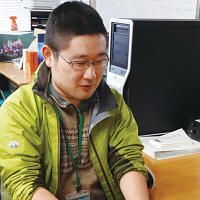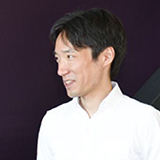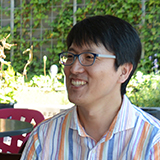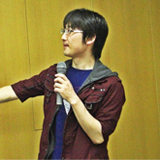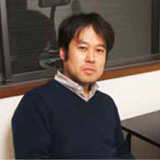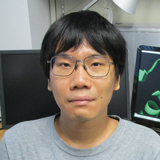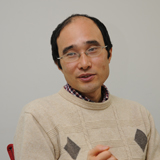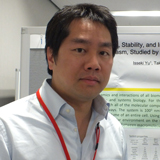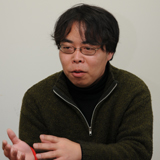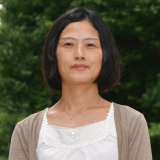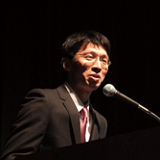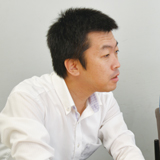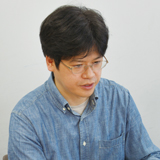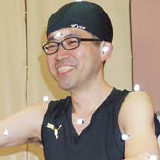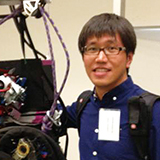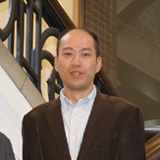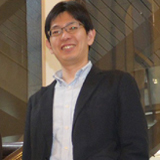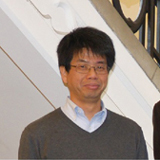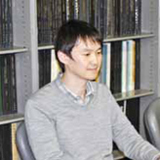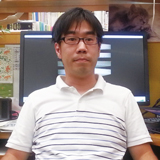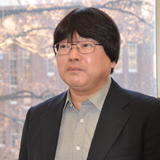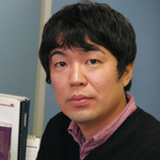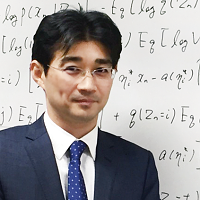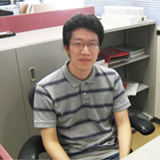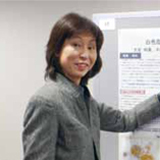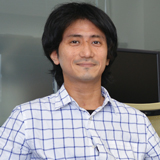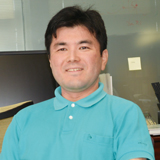Jinzen Ikebe
Special Topic Researcher, Molecular Modeling and Simulation Group, Japan Atomic Energy Agency
Jinzen Ikebe received his Ph.D. from Osaka University in 2011. After getting Ph.D, he served as a postdoctoral fellow at Osaka University. Since 2011, he has been working in the current position. His interest is developing new molecular dynamics simulation methods for conformational sampling of biomolecules such as proteins. In the current work, he studies application researches by using the new method, ALSD he developed.
His dream is to get a financially stable life. His favorite word is cost performance.
主要な論文掲載(査読あり)
- J.Ikebe, K.Umezawa, N.Kamiya, et al. (2011) Theory for Trivial Trajectory Parallelization of Multicanonical Molecular Dynamics and Application to a Polypeptide in Water. J. Comput. Chem., 32, 1286-1297.
- J.Ikebe. S.Sakuraba, H.Kono. (2014) Adaptive Lambda Square Dynamics Simulation: An Efficient Conformational Sampling Method for Biomolecules. J. Comput. Chem., 35, 39-50.
- J.Ikebe, K.Umezawa, J.Higo. (2016) Enhanced Sampling Simulations to Construct Free-Energy Landscape of Protein-Partner Substrate Interaction. Biophys. Rev., 8, 1-18
-
J.Ikebe, S.Sakuraba, H.Kono. (2016) H3 Histone Tail Conformation within the Nucleosome and the Impact of K14 Acetylation Studied Using Enhanced Sampling Simulation. PLoS Comput. Biol 12(3): e1004788.
dos: 10.1371/journal.pcbi.1004788
Takaharu Mori
RIKEN Theoretical Molecular Science Laboratory, Research Scientist
Takaharu Mori received his Ph.D. from Nagoya university in 2008.
His main research targets are membrane proteins and biological membranes,
and he is working on the development of new simulation techniques and analysis methods
for membrane systems and also working on application studies.
He was born in Kagawa, and his hobby is playing golf and listening to music.
Jaewoon Jung
RIKEN Advanced Institute for Computational Science (AICS), Computational Biophysics Research Team, Research Scientist
Jung received his Ph.D. from KAIST in 2005.
His main research is the theoretical development of molecular dynamics program. He was born in Korea, and now he is living with his wife and three sons.
Kazunari Iwamoto
Laboratory for Biochemical Simulation, RIKEN Quantitative Biology Center
Born in 1983.
- EDUCATION:
- Ph.D. in Systems Life Science, Kyushu University, 2010 (Prof. Masahiro Okamoto)
- B.S. in Agricultural chemistry, Kyushu University, 2005.
RESEARCH EXPERIENCES:
- Postdoctoral fellow, Laboratory for Biochemical Simulation (TL: Koichi Takahashi), QBiC, RIKEN since 2011.
- Research Fellow of the Japan Society for the Promotion of Science (DC2) in 2010.
RESEARCH THEME:
- Simulation of epidermal growth factor signaling pathway at the molecular resolution on K computer (present theme).
- Study on the effect of dynamic behavior of p53 on the cell fate decision using mathematical modelling (Ph.D theme).
学術誌における論文掲載(査読あり)
- Kazunari Iwamoto, Yoshihiko Tashima, Hiroyuki Hamada, Yukihiro Eguchi, Masahiro Okamoto, Mathematical modeling and Sensitivity analysis of G1/S phase in the cell cycle with involving the DNA damage signal transduction pathway, BioSystems, 94, 109-117, 2008.
- Hiroyuki Hamada, Kazunari Iwamoto, Taizo Hanai, Masahiro Okamoto, Sophisticated Framework between Cell Cycle Arrest and Apoptosis Induction Based on p53 Dynamics, PLoS ONE, 4(3), e4795, 2009.
- Kazunari Iwamoto, Hiroyuki Hamada, Yukihiro Eguchi, Masahiro Okamoto, Mathematical modeling of cell cycle regulation in response to DNA damage: Exploring mechanisms of cell-fate determination, BioSystems, 103, 384-391, 2011.
- Kazunari Iwamoto, Hiroyuki Hamada and Masahiro Okamoto: Mechanism of cell cycle disruption by multiple p53 pulses, Genome Informatics, 25(1), 12-24, 2011.
- Iwamoto, K., Hamada, H., Eguchi, Y., & Okamoto, M. (2014). Stochasticity of Intranuclear Biochemical Reaction Processes Controls the Final Decision of Cell Fate Associated with DNA >Damage. PloS one, 9(7), e101333.
主要な学会/ワークショップ等における発表(口頭)
- Kazunari Iwamoto et al., Mathematical modeling and Sensitivity analysis of G1/S phase in the cell cycle with involving the DNA damage signal transduction pathway, The Seventh International Workshop on IPCAT 2007, Oxford, 2007.
- Kazunari Iwamoto et al., Blind Spot of G1/S Checkpoint: G1/S Checkpoint is Invaded by DNA-Damage after R-Point, IASTED International Symposium on CBB, Orland, 2008.
- Kazunari Iwamoto et al., Mechanism of cell cycle disruption by multiple p53 pulses, The 2010 Annual Conference of the JSBi, Fukuoka, 2010.
- Kazunari Iwamoto et al., Simulation of EGF signaling pathway at the molecular resolution on K computer, The 10th JHUPO Conference, Tokyo, 2012. (Invited)
Yoshiteru Yonetani
Molecular Modeling & Simulation Group, Quantum Beam Science Directorate, Japan Atomic Energy Agency
Yoshiteru Yonetani was born in 1974 in Osaka, Japan. He graduated Keio University in 1998, and received his Ph.D from Keio University in 2002. After receiving his Ph.D, he spent six years as a postdoctoral researcher at Nara Women’s University (2002-2003) and at Japan Atomic Energy Agency (2004-2008). In 2008, he got a tenure track position at Japan Atomic Energy Agency, and in 2012 he became a senior researcher.
His research topic concerns computer simulation of condensed molecular systems. With the computer simulation approach called molecular dynamics, he has investigated various molecular events in chemistry and biology, which, for example, include DNA-protein interaction, water and hydrogen-bond dynamics, and crystal phase transition. These contributions have been published in the fields of biophysics and chemical physics.
[最近の論文]
- Dissociation free-energy profiles of specific and nonspecific DNA-protein complexes,
Y. Yonetani, H. Kono,
Journal of Physical Chemistry B, 117, 7535-7545 (2013). - What determines water-bridge lifetimes at the surface of DNA? Insight from systematic molecular dynamics analysis of water kinetics for various DNA sequences,
Y. Yonetani, H. Kono,
Biophysical Chemistry, 160, 54-61 (2012). - Molecular dynamics free energy calculations to assess the possibility of water existence in protein nonpolar cavities,
M. Oikawa, Y. Yonetani,
Biophysical Journal 98, 2974-2983 (2010). - Sequence dependencies of DNA deformability and hydration in the minor groove,
Y. Yonetani, H. Kono,
Biophysical Journal, 97, 1138-1147 (2009). - Comparison of DNA hydration patterns obtained using two distinct computational methods, molecular dynamics simulation and three-dimensional reference interaction site model theory,
Y. Yonetani, Y. Maruyama, F. Hirata, H. Kono,
Journal of Chemical Physics, 128, 185102 (2008). - Liquid water simulation: A critical examination of cutoff length,
Y. Yonetani,
Journal of Chemical Physics, 124, 204501 (2006).
最近の学会発表
- DNA-蛋白質の相互作用と自由エネルギー計算,
米谷 佳晃,
第4回計算統計物理学研究会, 山口, 2013年10月. - What determines water residence times at the surface of biomolecules?
Y. Yonetani, H. Kono,
Berkeley Mini Statistical Mechanics Meeting, California, Berkeley, 2012 Jan. - What determines water lifetimes at the surface of biomolecules?
Y. Yonetani, H. Kono,
6th International Meeting of Biomolecules under Pressure, Otsu, Japan, 2011 Dec. - Dynamics of water molecules and proteins interacting with DNA,
米谷 佳晃, 河野 秀俊,
日本生物物理学会第47回年会, 仙台, 2010年9月. - Sequence dependencies of DNA deformability and hydration in the minor groove,
Y. Yonetani, H. Kono,
Algorithms in Macromolecular Modeling Conference, Texas, Austin, 2009 Nov.
Yuichi Kokabu
Computational Life Science Laboratory, Graduate School of Medical Life Science, Yokohama City University.
He graduated from the Graduate School of Nanobioscience, Yokohama City University, and received Ph.D. degree in 2012. In 2013, he served as a postdoctoral fellow at the Graduate School of Medical Life Science, Yokohama City University. He studies molecular dynamics and molecular modelling using a computational chemical method. He utilizes his experience to perform a biochemical experiment, he is performing collaboration with experimental researcher. He want to find out the relation between protein dynamics and biochemical function by both computational and experimental methods. His hobby is gardening. He grows carnivorous plants.
発表論文(査読有り)
- Kokabu Y, Ikeguchi M. 2013. Molecular modeling and molecular dynamics simulations of recombinase Rad51. Biophys. J. 104:1556-1565.
- Saikusa K, Kuwabara N, Kokabu Y, Inoue Y, Sato M, Iwasaki H, Shimizu T, Ikeguchi M, Akashi S. 2013. Characterisation of an intrinsically disordered protein complex of Swi5-Sfr1 by ion mobility mass spectrometry and small-angle X-ray scattering. Analyst. 138:1441-1449.
- Kuwabara N, Murayama Y, Hashimoto H, Kokabu Y, Ikeguchi M, Sato M, Mayanagi K, Tsutsui Y, Iwasaki H, Shimizu T. 2012. Mechanistic insights into the activation of Rad51-mediated strand exchange from the structure of a recombination activator, the Swi5-Sfr1 complex. Structure. 20:440-449.
- Kokabu Y, Murayama Y, Kuwabara N, Oroguchi T, Hashimoto H, Tsutsui Y, Nozaki N, Akashi S, Unzai S, Shimizu T, Iwasaki H, Sato M, Ikeguchi M. 2011. Fission yeast Swi5-Sfr1 protein complex, an activator of Rad51 recombinase, forms an extremely elongated dogleg-shaped structure. J. Biol. Chem. 286:43569-43576.
- Downard KM, Kokabu Y, Ikeguchi M, Akashi S. 2011. Homology-modelled structure of the βB2B3-crystallin heterodimer studied by ion mobility and radical probe MS. FEBS J. 278:4044-4054.
Recently conference presentation
- Yuichi Kokabu, Tomotaka Oroguchi, Mitsunori Ikeguchi, Development of Coarse-Grained MD-SAXS method, The 14th Annual Meeting of the Protein Science Society of Japan, Yokohama City, Kanagawa, 2014
- Yuichi Kokabu and Mitsunori Ikeguchi, Comparison of ssDNA- and dsDNA-binding affinity of RecA recombinase using the PBSA method, The 3rd International conference on New Frontier of the Research on RecA-family recombinases and their accessory proteins at Nantes, Nantes, France, 2013
- Yuichi Kokabu, Mitsunori Ikeguchi, Comparison of ssDNA- and dsDNA-binding affinity of RecA recombinase using the PBSA method, The 51th Annual Meeting of the Biophysical Society of Japan, Kyoto city, Kyoto prefecture, 2013
- Yuichi Kokabu, Mitsunori Ikeguchi, Molecular modeling of Rad51 recombinase using molecular dynamics simulations, BIOPHYSICAL SOCIETY 57th ANNUAL MEETING, PHILADELPHIA, PENNSYLVANIA, 2013
- NewsLetter Vol.11 "Structural analysis of protein in solution by molecular dynamics simulation and small angle X-ray scattering "
- NewsLetter Vol.12 "Toward a reproduction of biomolecular functions in intracellular environments through large-scale simulation utilizing the high computational capabilities of the K computer"
Ryo Kanada
Program-Specific Researcher, Takada Laboratory, Department of Biophysics, Division of Biological Sciences, Graduate School of Science, Kyoto University
Ryo Kanada graduated from School of Engineering, Tohoku University and received Ph. D. in 2003 under supervision of Professor Kazuo Sasaki. After getting Ph. D, he worked for a private company as a system engineer (Apr. 2003-Jul. 2005) and spent two years (Aug. 2005-Jul. 2007) as a postdoctoral researcher at Kikuchi Laboratory, Large-Scale Computational Science Division, Cybermedia Center, Osaka University. Since Aug. 2007, he has been a program-specific researcher, at Kyoto University.
He has devoted himself to the research on the molecular motor “kinesin” to elucidate the mechano-chemical coupling mechanism by applying multi-scale molecular simulation. Currently, he belongs to the HPCI Strategic Program Field 1-theme 1: Simulation of Intracellular Molecular Dynamics and concentrates on the research of molecular mechanism of signal transduction of MAPK cascade by applying coarse grained molecular simulation with CafeMol software. His research is related to statistical physics, thermodynamics, molecular dynamics, biophysics, and so on.
Publications
- R. Kanada, T. Kuwata, H. Kenzaki, and S. Takada, Structure-based molecular simulations reveal the enhancement of biased Brownian motions in single-headed kinesin, PLoS Computational Biology 9, pp e1002907 (2013).
- R. Kanada and K. Sasaki, Energetics of the single-headed kinesin KIF1A, Phys. Rev. E 88, pp022711 (2013)
- H. Kenzaki, N. Koga, N. Hori, R. Kanada, W. Li, K. Okazaki, X. Yao, and S. Takada, Cafemol: A coarse-grained biomolecular simulator for simulating proteins at work, J. Chem. Theory Comp. 7, pp 1979-1989 (2011).
- K. Sasaki, R. Kanada and S. Amari, Efficiency of Energy Transduction in a Molecular Chemical Engine, J. Phys. Soc. Jpn. 76, pp023003 (2007)
- R. Kanada and K. Sasaki, Theoretical model for motility and processivity of two-headed molecular motors, Phys. Rev. E 67, pp061917 (2003)
- R. Kanada and K. Sasaki, Thermal Ratchets with Symmetric Potentials, J. Phys. Soc. Jpn. 68, pp3759-3762 (1999)
Presentations -excerpt-
- ○Ryo Kanada and Shoji Takada, “Mechanism of unidirectional move of KIF1A motor studied by coarse-grained simulations”, RIKEN Joint Computational Science Workshop 2009, RIKEN (Yokohama), July 9, 2009. [Oral, Invited]
- Ryo Kanada, Takeshi Kuwata, Hiroo Kenzaki and ○Shoji Takada, “Molecular motors at work studied by coarse-grained simulations”, International Symposium, Innovative Nanoscience of Supermolecular Motor Proteins Working in Biomembranes, (Kyoto University, Kyoto), September 9, 2009. [Oral, Invited]
- ○Ryo Kanada, Takeshi Kuwata, Hiroo Kenzaki and Shoji Takada, “MECHANISM OF UNIDIRECTIONAL MOVE OF KIF1A MOTOR STUDIED BY COARSE-GRAINED SIMULATIONS”, Biophysical Society 54th Annual Meeting, (San Francisco, California), February 21, 2010. [Poster]
- ○Ryo Kanada, Takeshi Kuwata, Hiroo Kenzaki, Tsukasa Makino, Michio Tomishige, and Shoji Takada: “Multiscale Biomolecular Simulations of Kinesin Motors”, The 2nd international symposium on "Multi-scale Simulations of Biological and Soft Materials (MSBSM 2011)", (Kyoto), September 11, 2011 [Oral]
- ○Ryo Kanada, Tsukasa Makino, Michio Tomishige and Shoji Takada, “Structural insights on coordinated walking of kinesin 1 by molecular simulations: Role of the internal tension on the nucleotide binding”, Nagoya Symposium - Frontiers in Structural Physiology, (Nagoya university, Nagoya), January 22-24, 2013 [Poster]
- ○Ryo Kanada and Shoji Takada, “Docking Dynamics of MAP kinase: MEK1-ERK2 Complex System Studied by Coarse-Grained Simulation”, Tokyo ATPase Workshop, (Tokyo Takeda Bldg, Takeda Hall, The University of Tokyo, Tokyo), Jun 2-3, 2014 [Poster]
- NewsLetter Vol.11 "Coarse-grained simulation : Investigation of the molecular mechanism of signaling pathway using CafeMol"
- NewsLetter Vol.12 "Toward a reproduction of biomolecular functions in intracellular environments through large-scale simulation utilizing the high computational capabilities of the K computer"
Hisashi Ishida
Senior Researcher, Quantum Beam Science Center, Japan Atomic Energy Agency
Graduate School of Science, Kyoto University, March 1998
Researcher at Japan Atomic Energy Institute, April 1998
Researcher at Japan Atomic Energy Agency, Oct 2005
Senior Researcher at Japan Atomic Energy Agency, Jul 2009
- Development of an integrated molecular simulation system for biomolecules, SCUBA, which has a high parallelization efficiency
- Analysis of functional mechanisms of biomolecules using SCUBA
論文
- Hisashi Ishida and Atsushi Matsumoto, Free-energy landscape of reverse tRNA translocation through the ribosome analyzed by electron microscopy density maps and molecular dynamics simulations, PLOS ONE, (2014), 9, e101951
- Hisashi Ishida, Essential function of the N-termini tails of the proteasome for the gating mechanism revealed by molecular dynamics simulations, Proteins: Structure, Function, and Bioinformatics, (2014), 82, 1985-1999
- Hisashi Ishida, Molecular dynamics simulation system for structural analysis of biomolecules by high performance computing, Progress in Nuclear Science and Technology, 2, 470-476 (2011)
- Hisashi Ishida, Branch migration of Holliday junction in RuvA tetramercomplex studied by umbrella sampling simulation using a path-search algorithm, J. Comput. Chem, 31, 2317-2329 (2010)
- Atsushi Matsumoto and Hisashi Ishida, Global conformational changes of ribosome observed by normal mode fitting for 3D cryo-EM structures, Structure, 17, 1605-1613 (2009)
- Guru P. Poornam, Atsushi Matsumoto, Hisashi Ishida and Steven Hayward, A method for the analysis of domain movements in large biomolecular complexes, Proteins, 76, 201-212 (2009)
- Hisashi Ishida and Steven Hayward, Path of nascent polypeptide in exit tunnel revealed by molecular dynamics simulation of ribosome, Biophysical Journal, 95, 5962-5973 (2008)
Isseki Yu
Research Scientist, RIKEN Theoretical Molecular Science Laboratory
I received my Ph.D in 2003 from the Yokohama National University, Graduate School of Material Engineering, and after that I worked in Nagoya University, Graduate School of Information Science for 5 years as a postdoc researcher. From 2008 to 2013, I was working in Aoyama Gakuin University, Department of Chemistry and Biological Science as an assistant professor. From 2013, I am working as research scientist in RIKEN, Theoretical Molecular Science Laboratory. Using the molecular dynamics (MD) simulation method, I am studying the influence of cellular environment on the structure, dynamics, and function of the proteins. For example, I studied the molecular mechanism of the osmolytes (small organic molecules which stabilize the protein structure) accumulated in the cell of extremophiles (organisms living in the extreme environment, such as salt lake or deep sea). Now, I am performing large-scale MD simulation of the realistic cellular environment in which many kinds of proteins, nucleic acids, metabolites are coexist with high concentration. How do biomolecules move, interact, and function in such highly crowded environment? This is one of the biggest questions in biology. To discover this mystery, I go to laboratory by "overcrowded" trains every day.
Recent main publications in the peer-reviewed journals
-
Michael Feig, Ryuhei Harada, Takaharu Mori, Isseki Yu*, Koichi Takahashi and Yuji Sugita.
Complete Atomistic Model of a Bacterial Cytoplasm for Integrating Physics, Biochemistry, and Systems Biology Journal of Molecular Graphics and Modelling.
J. Mol. Graph. Model., 58, 1–9 (2015).
- Isseki Yu*, Kyoko Nakada, Masataka Nagaoka
Spatio-Temporal Characteristics of Transfer Free Energy of Apomyoglobin into the Crowding Condition with Trimethylamine N-oxide: A Study with Three Types of the Kirkwood-Buff Integral
Journal of Physical Chemistry B, 116, 4080−4088, (2012). - Isseki Yu*, Masayoshi Takayanagi, Masataka Nagaoka
Influence of Hydrostatic Pressure on Dynamics and Spatial Distribution of Protein Partial Molar Volume: Time-Resolved Surficial Kirkwood-Buff Approach
Journal of Physical Chemistry B, 114, 12392-12397, (2010) - Isseki Yu*, Masayoshi Takayanagi, Masataka Nagaoka
Intrinsic Alterations in the Partial Molar Volume on the Protein Denaturation: Surficial Kirkwood−Buff Approach
Journal of Physical Chemistry B, 113, 3543-3547, (2009) - Eckhard Hitzer*, Kanta Tachibana, Sven Buchholz and Isseki Yu
Carrier Method for the General Evaluation and Control of Pose, Molecular Conformation, Tracking, etc.
Advances in Applied Clifford Algebras Vol. 19(2), pp. 339-364 (2009) - Isseki Yu, Masataka Nagaoka*
Microscopic Understanding of Preferential Exclusion of Compatible Solute Ectoine: Direct Interaction and Hydration Alteration
Journal of Physical Chemistry B, 111, 10231-10238, (2007). - Masayoshi Takayanagi, Isseki Yu, Masataka Nagaoka*
Theoretical Study on Stabilities of N-terminal Partial Chains from Apo-Myoglobin
Chemical Physics Letters, 421, 300-304, (2006). - Isseki Yu, Masataka Nagaoka*
Slowdown of Water Diffusion around Protein in Aqueous Solution with Ectoine
Chemical Physics Letters, 388, 316-321, (2004).
Recent International Symposiums
-
Date: 2015/7/16
Title: Atomistic molecular dynamics simulation of a complete model of bacterial cytoplasm
Name of the conference: 6th International Conference on Computational Methods (ICCM2015)
Author: Isseki Yu
Style: Invited - Date: 2014/2/17
Title:Space-Time Characteristics of the Protein Thermodynamic Quantities under the
Molecular Crowding Condition of Cytoplasm in Extremophiles:
Kirkwood-Buff Approach Combined with Molecular Dynamics Simulation
Name of the conference:The 58th annual meeting of Biophysical society
Author: Isseki Yu
Style: Poster - Date: 2013/11/20
Title: All-Atom Modelling and Molecular Dynamics Simulation of the Cytoplasm of Mycoplasma Genetalium
Name of the conference: The 3rd International Conference on Molecular Simulation (ICMS2013)
Author: Isseki Yu, Takaharu Mori, Jaewoon Jung, Ryuhei Harada, Michael Feig, Yuji Sugita
Style: Poster
Recent Internal Conferences
- Date: 2014/9/27
Title: Dynamics and Interactions of Macromolecules in the Bacterial Cytoplasm: All-atom Molecular Dynamics Study
Name of the conference: The 52th annual meeting of the Biophysical Society of Japan
Author: Isseki Yu, Takaharu Mori, Jaewoon Jung, Tadashi Ando, Ryuhei Harada, Michael Feig, Yuji Sugita
Style: Poster - Date: 2014/9/22
Title: Dynamics and Interactions of Macromolecules in the Cytoplasm of Mycoplasma Genitalium: All-atom Molecular Dynamics Study
Name of the conference: Workshop on Computer Modeling and Simulation of Biomolecular Systems
Author: Isseki Yu, Takaharu Mori, Jaewoon Jung, Tadashi Ando, Ryuhei Harada, Michael Feig, Yuji Sugita
Style: Oral - Date: 2014/3/27
Title: Diffusion Coefficients of Proteins and its Dependencies on the Crowding Level in the Cytoplasm of Mycoplasma Genitalium: The Theoretical Study Using Large-scale Molecular Dynamics Simulation.
Name of the conference: The 69th annual meeting of the Physical Society of Japan
Author: Isseki Yu, Takaharu Mori, Jaewoon Jung, Ryuhei Harada, Michael Feig, Yuji Sugita
Style: Oral
Invited lecture
- Date: 2013/10/5
Title: Three-dimensional Visualization of the Protein Transfer Free Energy by Kirkwood-Buff Integral Method: Toward the Microscopic Understanding of the Crowding Effect in the Cell.
Name of the conference: The 4th Workshop on Computational and Statistical Physics
Author: Isseki Yu, Takaharu Mori, Jaewoon Jung, Ryuhei Harada, Michael Feig, Yuji Sugita
Style: Oral
Motoshi Kamiya
Program-Specific Researcher, Department of Chemistry, Graduate School of Science, Kyoto University
Motoshi Kamiya graduated from Nagoya University in 2002, and received master’s degree in 2004 and Ph.D. degree in 2007 at Department of Chemistry, Graduate School of Science, Nagoya University. Since 2010, he has been working in the current position. He began his career as a classical MD calculation researcher, but now he has been working on developing a program for hybrid QM/MM calculations. He likes walking around the neighborhood and the internet.
- NewsLetter Vol.12 "Toward a reproduction of biomolecular functions in intracellular environments through large-scale simulation utilizing the high computational capabilities of the K computer"
- NewsLetter Vol.12 "Exploring a chemical reaction in an intracellular crowded environment by the QM/MM method "
Keiko Shinoda
Project assistant professor, Research Center for Advanced Science and Technology, The University of Tokyo
She graduated from terdisciplinary Graduate School of Science and Engineering, Tokyo Institute of Technology, and received Ph.D. degree in 2001. After that, she worked for the National Institute of Advanced Industrial Science and Technology (AIST) as a postdoctoral researcher for 6 years. And then, she worked for the Mitsubishi Chemical Group Science and Technology Research Center for 3 years. In 2010, She moved to the university of Tokyo, and has studied molecular dynamics for antibody drug development against cancer.
Takefumi Yamashita
(Project Associate Professor) Research Center for Advanced Science and Technology, The University of Tokyo
Takefumi Yamashita graduated from the Graduate School of Science, Kyoto University, and received Ph.D. degree (2004) under supervision of Professor Shigeki Kato. His doctoral thesis is about the molecular quantum dynamics in the photochemical reaction. Then he joined Professor Kazuo Takatsuka’s group, the University of Tokyo, as a postdoctoral researcher and studied the quantum dynamics theory. Here, I got interested in the proton transport of the membrane protein. In order to study the proton transport mechanism with the computational and theoretical methods, he transferred to the University of Utah (2007) and to the University of Chicago (2010) as a postdoctoral researcher (of Professor Gregory A. Voth’s group). Here, he also worked on the development of a molecular dynamics method that enables one to simulate the hydrated excess proton, which undergoes the chemical bond alternation.
He was promoted to Project Associate Professor in 2011. He concentrates on bridging between the computer-aided drug design technologies and a wide range of basic sciences including the molecular dynamics, statistical mechanics, thermodynamics, quantum chemistry, and molecular biology. He is also interested in the molecular recognition of a drug and the molecular mechanisms of protein functions.
[Selected Papers]
- T. Yamashita, Improvement in Empirical Potential Functions for Increasing the Utility of Molecular Dynamics Simulations, JPS Conf. Proc., 5 (2015), pp. 010003.
- T. Yamashita, A. Ueda, T. Mitsui, A. Tomonaga, S. Matsumoto, T. Kodama, and H. Fujitani, The Feasibility of an Efficient Drug Design Method with High-Performance Computers, Chem. Pharm. Bull., 63 (2015), pp. 147-155.
- T. Nakayama, E. Mizohata, T. Yamashita, S. Nagatoishi, M. Nakakido, H. Iwanari, Y. Mochizuki, Y. Kado, Y. Yokota, R. Satoh, K. Tsumoto, H. Fujitani, T. Kodama, T. Hamakubo, and T. Inoue, Structural features of interfacial tyrosine residue in ROBO1 fibronectin domain-antibody complex: Crystallographic, thermodynamic, and molecular dynamic analyses, Protein Sci., 24 (2015), pp. 328-340.
- T. Yamashita and H. Fujitani, On accurate calculation of the potential of mean force between antigen and antibody: A case of the HyHEL-10-hen egg white lysozyme system, Chem. Phys. Lett., 609 (2014), pp. 50-53.
- T. Yamashita, Properties of a Hydrated Excess Proton Near the Cholesterol-Containing Phospholipid Bilayer, JPS Conf. Proc., 1 (2014), pp. 013086
- Molecular Dynamics Simulation-Based Evaluation of the Binding Free Energies of Computationally Designed Drug Candidates: Importance of the Dynamical Effects
Takefumi Yamashita, Akihiko Ueda, Takashi Mitsui, Atsushi Tomonaga, Shunji Matsumoto, Tatsuhiko Kodama, and Hideaki Fujitani
Chem. Pharm. Bull.,62, 661-667 (2014) - On Accurate Calculation of the Potential of Mean Force between Antigen and Antibody: A Case of the HyHEL-10-Hen Egg White Lysozyme System
Takefumi Yamashita and Hideaki Fujitani
Chem. Phys. Lett. 609, 50-53 (2014) - Properties of a Hydrated Excess Proton near the Cholesterol-Containing Phospholipid Bilayer
Takefumi Yamashita
JPS Conf. Proc. 1, 013086 (2014) - On the origin of Proton Mobility Suppression in Aqueous Solutions of Amphiphiles
Jianqing Xu, Takefumi Yamashita, Noam Agmonm, and Gregory A. Voth
J. Phys. Chem. B, 117, 15426–15435 (2013) - High Performance Computing for Drug Development on K computer
Hideaki Fujitani, Keiko Shinoda, Takefumi Yamashita, and Tatsuhiko Kodama
JPCS (2013) (in press) - Insights into the Mechanism of Proton Transport in Cytochrome c Oxidase
Takefumi Yamashita and Gregory A. Voth
J. Am. Chem. Soc., 134, 1147–1152 (2012) - Computationally Efficient Multiconfigurational Reactive Molecular Dynamics
Takefumi Yamashita, Yuxing Peng, Chris Knight, and Gregory A. Voth
J. Chem. Theory Comput. 8, 4863–4875 (2012) - Hydrogen-bond assisted enormous broadening of infrared spectra of phenol-water cationic cluster: An ab initio mixed quantum-classical study.
Takefumi Yamashita and Kazuo Takatsuka
J. Chem. Phys. 126,074304 (15pages)(2007)
(Selected for Virtual Journal of Biological Physics Research of APS/AIP) - Excited-state electronic structures and dynamics of NOCl: A new potential function set, absorption spectrum, and photodissociation mechanism
Takefumi Yamashita and Shigeki Kato
J. Chem. Phys. 121, 2105-2116 (2004)
[International Conference]
- 2011/8/4
7th Congress of the International Society for Theoretical Chemical Physics(ISTCP-VII) (Tokyo/Poster)
Takefumi Yamashita and Gregory A. Voth
Effects of phospholipid bilayers on the hydrated excess proton behavior: A computational study - 2011/9/11
The 2nd international symposium on "Multi-scale Simulations of Biological and Soft Materials" (MSBSM 2011) (Kyoto/Oral)
Takefumi Yamashita and Gregory A. Voth
A computational study on the proton transport in cytochrome c oxidase - 2012/2/13
The International Conference on Statistical Mechanics of Liquids: From Water to Biomolecules (Okazaki/Poster)
Effects of phospholipid bilayers on the hydrated excess proton behavior: A computational study - 2012/6/7
CHI and Bio-IT World's Twelfth Annual Structure-Based Drug Design Conference (Boston/Oral(refereed))
Takefumi Yamashita
Toward Antibody Drug Development Assisted by Molecular Dynamics Simulations - 2012/11/30
6th International Symposium on Nanomedicine (ISNM2012) (Matsue・Oral(invited))
Takefumi Yamashita
Recent Progress of the Molecular Dynamics Methods for Biological Systems: from Proton Pump to Drug Design - 2013/03/24
CSJ/Asian International Symposium –Theoretical Chemistry, Chemoinformatics, Computational Chemistry- (Kusatsu・Invited Lecture)
Takefumi Yamashita
Recent Progresses of the Molecular Dynamics Simulation Methods: From a Proton Pump Function to Drug Design - 2013/06/17
The 12th Asia Pacific Physics Conference of AAPPS (APPC12)(Makuhari/Poster)
Takefumi Yamashita
On the Properties of the Hydrated Excess Proton near Lipid Bilayers: a Molecular Dynamics Study on Cholesterol Effects - 2013/10/17
Takefumi Yamashita
CMSI International Satellite Meeting in NAGOYA (Nagoya/Invited lecture)
Molecular Dynamics study on Proton Behavior in aqueous and biological environments - 2013/11/08
Takefumi Yamashita
7th International Symposium of Nanomedicine (ISNM2013) (Kita-Kyusyuu/Invited lecture)
Toward a better understanding of the molecular recognition mechanism: A molecular dynamics study - 2013/11/19
3rd International Conference on Molecular Simulation (ICMS2013)(Kobe/Poster)
Takefumi Yamashita
A Molecular Dynamics Study on the Antigen-Antibody Interactions - 2013/12/05
5th JCS International Theoretical Chemistry(Nara/Invited Lecture)
Takefumi Yamashita
Proton Transport in biomolecular and aqueous systems: A Molecular Dynamics Approach - 2014/08/06
2014 International Biophysics Congress (IUPAB2014)(Brisbane, Austraria/Poster)
Takefumi Yamashita
A molecular dynamics study on the molecular recognition and a challenge to drug design -
2014/08/22
Computational Science Workshop 2014 (CSW2014)(Tsukuba, Invited lecture)* Takefumi Yamashita A molecular dynamics simulation studies on the biological functions and roles of water -
2014/11/10
International Symposium on Extended Molecular Dynamics and Enhanced Sampling: Nosé Dynamics 30 Years (NOSE30)(Tokyo/Poster)
Takefumi Yamashita
A molecular dynamics study on the molecular recognition and a challenge to drug design
Nozomu Kamiya
Manager
Bio-IT R&D Office, Research & Development Division, Next-Generation Healthcare Innovation Center, Fujitsu Limited
Nozomu Kamiya graduated from Hokkaido University in 1991.
He got into Fujitsu Limited after completion of master's degree in 1993, and had worked for software development for computational chemistry.
He got into the BioIT Business Development Unit when Fujitsu established it in 2004, and was engaged in a drug discovery information project.
Now, he is working for designing drug candidate.
[International conference]
- Abstract fragment based de novo novel compound generation,
Nozomu Kamiya, Akihiko Ueda, Takashi Mitsui, Tatsuhiro Yamashita, Atsushi Tomonaga, Shunji Matsumoto,
11th CHI's Structure-Based Drug Design Conference, 2011 Jun. (Boston/poster presentation)
[Domestic conference]
- A system for designing drug candidates with large-scale super-computer,
紙谷 希、山下辰博、朝永 惇、松本俊二,
第16回問題解決環境(PSE)ワークショップ, 2013 - Application of in silico drug discovery technology to Perkinson's disease,
Nozomu Kamiya,
91st Annual Meeting of The Chemical Society of Japan, 2011 - in silico での FBDD の実際,
紙谷 希,
第276回CBI学会研究講演会, 2007 - タンパク質とリガンド結合ジオメトリの新たな推定法の試み,
紙谷 希、上田明彦、朝永 惇、塩原紀行、輪湖 博,
第29回情報化学討論会, 2006
Takashi Mitsui
Bio-IT R&D Office, Research & Development Division, Next-Generation Healthcare Innovation Center, Fujitsu Limited
Takashi Mitsui graduated from the University of Tokyo in 1993.
He got into Fujitsu Limited after completion of master's degree in 1995, and had worked for software development for computational chemistry.
He got into the BioIT Business Development Unit when Fujitsu established it in 2004, and was engaged in a drug discovery information project.
Now, he is working for designing drug candidate.
[Published paper (selected papers)]
- Molecular Dynamics Simulation-Based Evaluation of the Binding Free Energies of Computationally Designed Drug Candidates:
Importance of the Dynamical Effects,
Takefumi Yamashita, Akihiko Ueda, Takashi Mitsui, Atsushi Tomonaga, Shunji Matsumoto, Tatsuhiko Kodama, Hideaki Fujitani
Chemical and Pharmaceutical Bulletin, 62, 661 (2014) - Docking study and binding free energy calculation of poly (ADP-ribose) polymerase inhibitors,
Kazuki Ohno, Takashi Mitsui, Yoshiaki Tanida, Azuma Matsuura, Hideaki Fujitani, Tatsuya Niimi, Masaya Orita,
Journal of Molecular Modeling, 17, 389 (2011) - Comparison of binding affinity evaluations for FKBP ligands with state-of-the-art computational methods:
FMO, QM/MM, MM-PBSA and MP-CAFEE approaches,
Hirofumi Watanabe, Shigenori Tanaka, Noriaki Okimoto, Aki Hasegawa, Makoto Taiji, Yoshiaki Tanida,
Takashi Mitsui, Mariko Katsuyama, Hideaki Fujitani
Chem-Bio Informatics Journal, 10, 32 (2010) - Wang-Landau molecular dynamics technique to search for low-energy conformational space of proteins,
Takehiro Nagasima, Akira R. Kinjo, Takashi Mitsui, and Ken Nishikawa,
Physical Review E, 75, 066706 (2007)
[International conference]
- Refinement of the dihedral potential functions for nucleic acids backbone,
Takashi Mitsui and Hideaki Fujitani,
18th International Biophysics Congress, 2014 Aug. (Brisbane/Poster) - Accurate binding affinity prediction with massively parallel computation,
Takashi Mitsui, Nozomu Kamiya, Yoshiaki Tanida, Azuma Matsuura, Tatsuhiro Yamashita, Atsushi Tomonaga, Shunji Matsumoto,
11th CHI's Structure-Based Drug Design Conference, 2011 Jun. (Boston/Poster)
[Domestic conference]
- 薬剤標的タンパク質MDM2とその高親和性ペプチド間の結合自由エネルギー計算に基づく相互作用解析,
三井崇志、始平堂弘和、宮本悦子、柳川弘志
Biosupercomputing Symposium, 2008 - Computational alanine scanning of MDM2 inhibitor peptides optimized by an in vitro virus selection,
Takashi Mitsui, Hirokazu Shiheido, Etsuko Miyamoto-Sato, Hiroshi Yanagawa,
The 2nd Biosupercomputing Symposium, 2010
Akihiko Murai
Digital Human Reserach Group, Human Informatics Research Institute, National Institute of Advanced Industrial Science and Technology
Akihiko Murai received his Ph.D. degrees in Mechano-Informatics in 2009 from the University of Tokyo, Japan. He is currently a Research Scientist at National Institute of Advanced Industrial Science and
Technology (AIST).
Prior to joining AIST, he was Postdoctoral Researcher at Disney Research, Pittsburgh, Carnegie Mellon University, and Project Assistant Professor at the University of Tokyo.
He also worked for Mitsubishi Heavy Industrial Company and engaged in the production of the shield machines and the large size structures.
He is interested in the mechanism of the human movement and engaged in the research about the human modeling and the motion analysis based on the model.
He has built the human whole-body musculoskeletal model with modeling all the human muscles in anatomically detail, and realized the kinematics, dynamics computation of the human movement, the human muscle activity estimation, and the real-time visualization of the muscle activity.
He is interested in the sports and the trainings that relate to his research, and the moviegoing. He got his job at Disney Research because he is a big fan of Disney and PIXAR.
雑誌論文掲載 査読あり
- "Musculoskeletal-see-through mirror: computational modeling and algorithm for whole-body muscle activity visualization in real time",Murai, A., Kurosaki, K., Yamane, K., and Nakamura, Y., Progress in Biophysics and Molecular Biology, Volume 103, Issues 2-3, pp. 310-317, 2010.
- “Musculoskeletal Modeling and Physiological Validation”, Murai,A.,Takeichi, K., Miyatake, T., and Nakamura, Y., IEEE Intern. Workshop on Advanced Robotics and its Social Impacts, SAcT1.1, 2014.
- "A Neuromuscular Locomotion Controller that Realizes Human-like Responses to Unexpected Disturbances", Murai, A., and Yamane, K., IEEE International Conference on Robotics and Automation 2011, pp. 1997-2002, 2011.
-
"Method and Device for Estimating Muscle Tension", Nakamura, Y, Yamane, K, Murai, A, and Kurosaki, K, 国際特許, WO 2010/095636, 2010.
-
"Muscular strength acquiring method and device based on musculoskeletal model", Nakamura, Y., Yamane, K., Fujita, Y., and Murai, A., WO/2005/122990, 2005.
-
"リアルタイム筋張力提示プログラム",中村仁彦,山根克,村井昭彦,鮎澤光, 東京大学継承著作物, 2012.
-
NHKスペシャル MIRACLE BODY サッカー・FIFAワールドカップ 第2回 スペイン代表 (2014年6月8日放映)
Chunjiang Fu
Post-Doctoral Fellow,
Division of Bioengineering, Graduate School of Engineering Science,
Osaka University
I received the Ph.D. degrees in mechanical science and bioengineering from Osaka University, Japan, in 2014. I am currently a post-doctoral fellow at Osaka University. My research interest is the field of neuromechanics, in particular, neural control of human bipedal walking. My background is electronic engineering and control theory. Previously, I also did some research on human arm optimal control and impedance control.
最近の主要な論文掲載(査読有)
C. Fu, Y. Suzuki, K. Kiyono, P. Morasso, and T. Nomura,
An intermittent control model of flexible human gait using a stable manifold of saddle-type unstable limit cycle dynamics, Journal of The Royal Society Interface, 11 (101), 20140958, 2014.
Kazuya Shimizu
Research Associate, School of Engineering, The University of Tokyo
2002年3月東京工業大学大学院総合理工学研究科創造エネルギー専攻博士課程修了。工学博士。これまで主に電磁流体・混相流・燃焼流などの数値流体力学に関する研究に従事。2011年4月より現職。骨格筋の挙動の解析に有限要素法を適用し、また、中枢神経系の活動にコンダクタンスベースのニューロンモデルを適用し、それらを連成させた階層統合シミュレーショモデルの開発に取り組んでいる。モデルの確立により、パーキンソン病などの神経変性疾患に対する医療貢献を目指している。
Naoto Yamamura
Research Associate, School of Engineering, The University of Tokyo
2002年、東京農工大学において博士(工学)を取得する。博士論文では、金属板材のプレス成形解析におけるスプリングバック解析の高精度化に関する研究を行った。その後、理化学研究所、生体力学シミュレーション特別研究ユニットにおいて、脳神経外科医のためのトレーニングシミュレータの開発、さらに、次世代計算科学研究開発プログラムの研究員として、ヒト骨格筋の収縮挙動と骨格の関節運動を再現する3次元筋骨格系力学シミュレータの開発を行った。
現在、東京大学大学院 工学系研究科において、コンピュータ・シミュレーションによる脳神経疾患の運動機能障害の病態予測と治療支援を目指して、ヒト全身の神経-筋-骨格系の統合シミュレーションシステムの構築を行なっている。特に、脊髄の運動神経への刺激入力と運動単位を考慮した筋線維レベルからのマルチスケール・マルチフィジックス筋収縮モデルの開発を行なっている。
研究分野は、計算力学・連続体力学・非線形有限要素法などを駆使して、実験が困難な問題をコンピュータ・シミュレーションにより仮想的に解き、そこで起こっている現象を理解し予測するための新しい手法の開発を行っている。特に、工学的な観点から、製造業や医療現場で活用することのできるシミュレータの開発を目指している。
論文・国際会議等
- Naoto Yamamura, Kazuya Shimizu, Shu Takagi, "3D FEM Simulation of Skeletal Muscle Contraction with Motor-unit Activity", XIV International Symposium on Computer Simulation in Biomechanics, (2013).
- Naoto Yamamura, J.L. Alves , Toshiaki Oda, Ryuta Kinugasa, Shu Takagi, “Significance of fascia for mechanical behavior of skeletal muscles -Numerical study using 3D models-”, CMBBE-Computer Methods in Biomechanics and Biomedical Engineering 2012.
- Luis ALVES, Naoto YAMAMURA, Toshiaki ODA and Cristian TEODOSIU, “Numerical simulation of musculo-skeletal systems by V-biomech”, CMBBE– Computer Methods in Biomechanics and Biomedical Engineering 2010.
- J.L. Alves, N. Yamamura, T. Oda, C. Teodosiu, “NUMERICAL SIMULATION OF MUSCLE- SKELETAL SYSTEMS BY V-BIOMECH”, ECCOMAS – INTERNATIONAL CONFERENCE ON TISSUE ENGINEERING, (2009).
口頭発表等
- 山村 直人,清水和弥,高木周,“パーキンソン病振戦の 3 次元 FEM シミュレーション”,日本機械学会2013年度年次大会講演論文集,(2013.9)
- 山村 直人,高木周,“運動単位を考慮した骨格筋の3次元FEMシミュレーション”,日本機械学会2012年度年次大会講演論文集,(2012.9)
- 衣笠竜太,山村直人,石川昌紀,谷口圭吾,藤宮峯子,片寄正樹,小田俊明,“アキレス腱屈曲点の出現メカニズムとその機能的意義”,第67回日本体力医学会大会,(2012.9).
- 山村直人, Luis ALVES, 高木周,“筋骨格系力学解析のための3次元有限要素シミュレータの開発”,文部科学省「革新的ハイパフォーマンス・コンピューティング・インフラ(HPCI)の構築」 次世代ナノ統合シミュレーションソフトウェアの研究開発(ナノ) 次世代生命体統合シミュレーションソフトウェアの研究開発(ライフ) 公開シンポジウム,(2012.3).
- 山村直人, Luis ALVES, 小田俊明, 衣笠竜太,高木周,”材料パラメータが骨格筋の力発揮能力に及ぼす影響 - 3次元FEMによる下腿三頭筋の等尺性収縮シミュレーション”,機械学会第24回バイオエンジニアリング講演会講演論文集,(2012.1).
- 衣笠竜太,狩野豊,小田俊明,稲垣薫克,山村直人,高木周,“ラット足背屈張力は前脛骨筋の膜組織の切除に伴って低下する”,第66回日本体力医学会大会,(2011.9).
- 山村 直人, Luis ALVES, 小田俊明, Cristian TEODOSIU,”材料パラメータが骨格筋の力発揮能力に及ぼす影響 - 3次元FEMによる下腿三頭筋の等尺性収縮シミュレーション”,機械学会第23回バイオエンジニアリング講演会講演論文集,pp. 325-326 (2011.1).
- N. Yamamura, J.L. Alves, T. Oda, C. Teodosiu, “Development of a Finite Element Simulator for Mechanical Analysis of Human Skeletal Muscle”, 6th World Congress on Biomechanics, (2010.8).
- 山村 直人, Luis ALVES, 小田俊明, Cristian TEODOSIU,”筋収縮を考慮したヒト骨格筋の有限要素シミュレーション”,機会学会第22回バイオエンジニアリング講演会講演論文集,p. 150 (2010.1).
- Naoto YAMAMURA, Luis ALVES, Toshiaki ODA and Cristian TEODOSIU, “Development of the Finite Element Simulator for Mechanical Analysis of Human Skeletal Muscle”, Workshop on Multi-Scale Muscle Mechanics, (2009.9).
- 山村 直人, Luis ALVES, 小田俊明, Cristian TEODOSIU,”ヒト骨格筋力学解析のための有限要素シミュレータの開発”,機械学会2009年度年次大会講演論文集 (6),pp. 29-30 (2009.9).
Takumi Washio,
Graduate School of Frontier Sciences, The University of Tokyo,
Project Associate Professor
Takumi Washio has worked at Computational Biomechanics Laboratory, School of Frontier Sciences, the University of Tokyo since 2004. After he received M.S. degree in Mathematics from Osaka University in 1990, he joined NEC Corporation where he worked for computer hardware design for the first two years, and then worked in the area of fast algorithms for supercomputers. He moved to the current position in 2004. Since then he has engaged in developments of multi-scale and multi-physics heart simulator.
発表論文
[主要論文]
- Multiscale Heart Simulation with Cooperative Stochastic Cross-Bridge Dynamics and Cellular Structures; Takumi Washio, Jun-ichi Okada, Akihito Takahashi, Kazunori Yoneda, Yoshimasa Kadooka, Seiryo Sugiura and Toshiaki Hisada, SIAM Multiscale Model. Simul., 11, 965 – 999 (2013).
- Approximation for Cooperative Interactions of a Spatially-Detailed Cardiac Sarcomere Model, Takumi Washio, Jun-ichi Okada, Seiryo Sugiura and Toshiaki Hisada, Cell Mol. Bioeng., 5, 113-126 (2012).
- A Parallel Multilevel Technique for Solving the Bidomain Equation on a Human Heart with Purkinje Fibers and a Torso Model, Takumi Washio, Jun-ichi Okada and Toshiaki Hisada, SIAM Rev. 52, 717-743 (2010).
学会発表
[国際学会発表]
- T. Washio and T. Hisada, “Lagrange Multiplier Approach to Fluid-Structure Interaction Problems of Heart Valves”, ICCM2007 International Conference on Computational Methods, April 4-7 2007, Hiroshima
- T. Washio, J. Okada and T. Hisada, “Parallel Computing techniques for the multiphysics heart simulator”, ICCM2007 International Conference on Computational Methods, April 4-7 2007, Hiroshima.
- T. Washio and T. Hisada, “Parallel fluid-structure interaction solver with Lagrange multiplier approach for heart valve simulations”, APCOM’07 in conjunction with EPMESC XI, December 3-6, 2007, Kyoto, JAPAN.
- T. Washio, J. Okada, A. Hosoi and T. Hisada, “Efficient Parallel Solution Techniques of Homogenization Method for Nonlinear Problems and its Application to Multi-Scale Heart Simulations”, 15th International Conference on Finite Elements in Flow Problems, April 1-3, 2009, Tokyo.
- T. Washio, J. Okada, S. Sugiura, T. Hisada, “Large-scale integrated model is useful for understanding heart mechanisms and developments of medical therapy”, Engineering in Medicine and Biology Society, 2009. EMBC 2009, Annual International Conference of the IEEE, Sept. 3-6, 2009, Minneapolis, U.S.A.
- T. Washio, “High performance computing in "UT-heart" simulator for understanding heart mechanisms and developments of medical therapy”, 11th Teraflop workshop, Oct. 19-20 2009, Tohoku University, Japan.
- T. Washio, J. Okada, S. Sugiura and T. Hisada, “HPC Techniques for a Heart Simulator”, 9th International Conference VECPAR 2010, June 22-24 2010, Berkeley, CA, USA (Invited Talk).
- A. Hosoi A, T. Washio(Speaker), J. Okada, Y. Kadooka, K. Nakajima, T. Hisada, “A Multi-Scale Heart Simulation on Massively Parallel Computers”, ACM/IEEE Supercomputing Conference(SC10), Nov. 2010, New Orleans, U.S.A.
- T. Washio and T. Hisada “A Shared Memory Parallel Iterative Solver for Heart Simulations”, Int. Workshop on application of iterative methods to engineering and its mathematical element, Oct. 23-24, Kyoto, Japan.
- T. Washio, J. Okada, S. Sugiura and T. Hisada, “HPC Techniques for a Heart Simulator”, Singapore - Japan High Performance Computing Workshop, Feb. 27 2012, Singapore.
- T. Washio, “Numerical modeling and its solution techniques for multiphysic and multiscale heart simulator: UT-heart”, Numerical Linear Algebra -Algorithms, Applications, and Training An NWO-JSPS joint Seminar, April 13 2012, Delft, Netherlands.
- T. Washio, “Applications of UT-Heart Multiscale Heart Simulator on K Computer”, International Supercomputing Conference (ISC13), June 16-20, 2013, Leipzig, Germany.
Ko Ayusawa
Project Assistant Professor, Graduate School of Information Science and Technology, University of Tokyo,
(until March 31, 2014)
Ko Ayusawa graduated from the Graduate School of Information Science and Technology, University of Tokyo, and received Ph.D. degree in 2011. In 2011, he served as a project researcher in the same department, and is now a project assistant professor. He has worked in the field of robotics: kinematics, dynamics, identification, and mathematical optimization of humanoids. He also has been developing the computational framework of estimating human model, sensation and motion. He mainly works on the HPCI Strategic Program Field 1-Theme 3: Hierarchical Integrated Simulation for Predictive Medicine, and concentrates to the research on the integrated musculoskeletal whole-body model and spine model.
Since leaving the HPCI Strategic Program in April 1, 2014, he has been engaged in research on humanoid robots and human motion simulation for evaluation of robotic devices for nursing care in the Intelligent Systems Research Institute of the National Institute of Advanced Industrial Science and Technology.
He likes to go on trips to hot springs, and recently started horseback riding.
Journal papers (first author)
- K. Ayusawa, Y. Ikegami, and Y. Nakamura, “Simultaneous Global Inverse Kinematics and Geometric Parameter Identification of Human Skeletal Model from Motion Capture Data”, J. of Mechanism and Machine Theory, 2014 (in press).
- K. Ayusawa, G. Venture, and Y. Nakamura, “Identifiability and Identification of Inertial Parameters Using the Underactuated Base-Link Dynamics for Legged Multibody Systems,” Int. J. of Robotics Research, DOI:10.1177/0278364913495932, 2013.
Conference papers with reviews (first author)
- K. Ayusawa and Y. Nakamura, “Fast Inverse Kinematics Algorithm for Large DOF System with Decomposed Gradient Computation Based on Recursive Formulation of Equilibrium,” Proc. of 2012 IEEE/RSJ Int. Conf. on Intelligent Robots and Systems, pp. 3447-3452, 2012.
- K. Ayusawa, G. Venture and Y. Nakamura, “Real-time Implementation of Physically Consistent Identification of Human Body Segments,” Proc. of the 2011 IEEE Int. Conf. on Robotics and Automation, pp.6282-6287, 2011.
- K. Ayusawa and Y. Nakamura, “Inverse Kinematics Based on High-Order Moments of Feature Points and Their Jacobian Matrices,” Proc. of the 2011 IEEE Int. Conf. on Robotics and Automation, pp.3530-3535, 2011.
- K. Ayusawa and Y. Nakamura, “Identification of Standard Inertial Parameters for Large-DOF Robots Considering Physical Consistency,” Proc. of the 2010 IEEE/RSJ Int. Conf. on Intelligent Robots and Systems, pp.6194-6201, 2010.
- K. Ayusawa, G. Venture and Y. Nakamura, “Identification of Flying Humanoids and Humans.” Proc. of the 2010 IEEE Int. Conf. on Robotics and Automation, pp.3715-3720, 2010.
- K. Ayusawa, G. Venture and Y. Nakamura, “Symbolic Proof of Inertia-Parameter Identifiability of Legged Mechanisms from Unactuated Base-Link Dynamics,” Proc. of the 15th IFAC Symp. on Systems Identification, pp.693-698, 2009.
Jun Igarashi
Okinawa Institute of Science and Technology (OIST), Neural Computing Unit.
He is from Chiba, Japan. He graduated the Department of Applied Biological Science in Faculty of Science and Technology of Tokyo University of Science in 2002. He graduated with a PhD from the Department of Brain Science and Engineering in Graduate School of Life Science and Systems Engineering of Kyushu Institute of Technology in 2007. He worked for Kyushu Institute of Technology as a researcher from 2007-2009, and worked for Honda Research Institute as a visiting researcher in 2008. Then, he worked for RIKEN as a researcher from 2009 to 2013. He has been working for OIST as a researcher from 2013 to now.
In OIST, he has studied the relationship among motor cortex including thalamus, Parkinson’s disease symptoms, and information processing of movement behavior by simulation. His previous research topics were 1) sequence learning in entorhinal cortex with entorhinal-hippocampal loop circuits, 2) large scale simulation of neural network model using Cell processor, 3) real-time simulation of a basal ganglia model using GPGPU, 4) and oscillatory neural activities in theta and gamma frequency ranges in rat motor cortex during voluntary movement behaviors. His favorite food is a ramen. His recent hobby is to explore in Okinawa searching for ramen shops.
最近の論文
- Jun Igarashi, Yoshikazu Isomura, Kensuke Arai, Harukuni R, Fukai T.
A θ-γ oscillation code for neuronal coordination during motor behavior.
Journal of Neuroscience, Vol. 33, pp. 18515-18530 (2013) - Moritz Helias, Susanne Kunkel, Gen Masumoto, Jun Igarashi, Jochen Martin Eppler, Shin Ishii, Tomoki Fukai, Abigail Morrison, and Markus Diesmann, Supercomputers ready for use as discovery machines for neuroscience, Frontiers in Neuroinformatics, Vol.6, 26 (2012).
- Tadashi Yamazaki, and Jun Igarashi, Realtime Cerebellum: Realtime Simulation of a Realistic Cerebellar Model using a GPU for Real-World Engineering Applications. GPU Technology Conference (2012).
- Jun Igarashi J, Osamu Shouno, Tomoki Fukai, Hiroshi Tsujino, Real-time simulation of a spiking neural network model of the basal ganglia circuitry using general purpose computing on graphics processing units. Neural Networks, Vol.24, pp. 950-960 (2011)
- Hatsuo Hayashi and Jun Igarashi, LTP windows of the STDP learning rule and synaptic connection having a large transmission delay enable robust sequence learning amid background noise, Cognitive Neurodynamics, Vol.3, pp.119-130 (2009).
- Jun Igarashi, Hatsuo Hayashi, and Katsumi Tateno, Theta Phase Coding in a Network Model of the Entorhinal Cortex Layer II with Entorhinal-Hippocampal Loop Connections, Cognitive Neurodynamics, Vol.1, pp.169-184 (2007).
- Jun Igarashi, Katsumi Tateno, and Hatsuo Hayashi, Phase coding by organization of entorhinal cortex-hippocampus loop circuits, Brain-Inspired IT II International Congress Series 1291, pp.117-120 (2006).
学会発表、及び講演活動
- 五十嵐潤、
「京コンピュータによる神経回路モデルの大規模計算と運動皮質モデルの開発:パーキンソン病の疾患の再現を目指して」、電子通信情報通信学会、ニューロコンピューティング研究会、2014 - 五十嵐潤、「京」で脳を再現する -パーキンソン病の治療を目指して-、「京」を知る会in盛岡 (2013)
- Jun Igarashi, Yoshikazu Isomura, Ken Arai, Rie Harukuni, Tomoki Fukai, An oscillation code for voluntary movements in motor cortex: Comparison with hippocampal oscillatory code, Society for Neuroscience (2012).
- 五十嵐潤、「GPUによるデータ並列とタスク並列:大脳基底核モデルの実時間実行への応用」、 日本学術会議 第1回計算力学シンポジウム、(2011)
- Jun Igarashi, Yoshikazu Isomura, Rie Harukuni, Tomoki Fukai, Spike phase-locking to slow and fast gamma oscillations in motor cortex of behaving rat. COSYNE (2011 ).
- Jun Igarashi, Yoshikazu Isomura, Rie Harukuni, Tomoki Fukai, Slow and fast gamma oscillatory activities in identified cortical neurons of behaving rats. Society for Neuroscience (2010).
Norio Shimamoto
Research Associate, School of Engineering, The University of Tokyo,
Norio Shimamoto graduated from the Graduate School of Engineering, The University of Tokyo, and received the M.E. degree in Mechanical Engineering in 1989. He joined Nippon Telegraph and Telephone Corporation (NTT), where he was engaged in research on the routing control methods using Genetic Algorithms, and the development of switching system software for telephone networks. He received the Ph.D. degree in Mechanical Engineering from the University of Tokyo in 2011. His doctoral thesis is about mathematical modeling based on fractional calculus for diffusive transport in fractal structure. Then he moved to the current position, and has been engaged in the development of platelet activation model in the thrombosis simulator.
Seiji Shiozaki
Research Associate, Division of Cardiovascular Medicine, Department of Internal Medicine, Tokai University School of Medicine
Seiji Shiozaki graduated from Department of Mechanical Engineering, The University of Tokyo and received Ph. D. in 2007. After receiving his Ph.D., he spent six years as a postdoctoral researcher at the University of Tokyo (2007-2008), at Toyo University (2008-20010) and at RIKEN (2010-2012). Since Oct. 2012, he has been a research associate, at Tokai University. His research topic concerned Multiscale simulations on the thrombus formation using molecular dynamics or Monte Carlo method. His hobbies are riding a bicycle and taking pictures.
Publications
- Aiko Tomita, Noriko Tamura, Yohei Nanazawa, Seiji Shiozaki, Shinya Goto, "Development of Virtual Platelets Implementing the Functions of Three Platelet Membrane Proteins with Different Adhesive Characteristics", Journal of Atherosclerosis and Thrombosis, to be published.
- Seiji Shiozaki, Kenichi L. Ishikawa, Shu Takagi, "Numerical Study on Platelet Adhesion to Vessel Walls using the Kinetic Monte Carlo Method", Journal of Biomechanical Science and Engineering, Vol. 7, No.2, pp.275-283, 2012.
Presentations
- Seiji Shiozaki, Shu Takagi, "Kinetic Monte Carlo Simulation of Platelet Adhesion on a Vessel Wall", 10th World Congress on Computational Mechanics, 2012.7.
Seiya Imoto
Professor, Health Intelligence Center, the Institute of Medical Science, the University of Tokyo
Seiya Imoto was graduated from Department of Mathematics, Undergraduate school of Kyushu University in 1996 and received Ph.D. in mathematics in 2001. He was awarded as a Research Fellow of the Japan Society for the Promotion from Jan 1999 to March 2001. In April 2001, he joined to Human Genome Center, the Institute of Medical Science, the University of Tokyo as a postdoctoral researcher. He was an assistant professor (Dec 2001~), associate professor (Feb 2007~) and is currently a professor of Health Intelligence Center (May 2015~).
His research covers development of supercomputer-oriented statistical data analysis techniques for genomic data. He would like to utilize various time series data of medical and health fields in order to develop novel treatment and prevention of diseases and methods for improving health.
論文(査読有り)
- Hasegawa T, Niida A, Moria T, Shimamura T, Yamaguchi R, Miyano S, Akutsu T, Imoto S. A likelihood-free filtering method via approximate Bayesian computation in evaluating biological simulation models, Computational Statistics and Data Analysis, 94, 63-74 (2016).
- Chiba K, Shiraishi Y, Nagata Y, Yoshida K, Imoto S, Ogawa S, Miyano S. Genomon ITDetector: A tool for somatic internal tandem duplication detection from cancer genome sequencing data. Bioinformatics, 31(1), 116-118 (2015).
- Park H, Niida A, Miyano S, Imoto S. Sparse overlapping group lasso for integrative multi-omics analysis. J Computational Biology. 22(2), 73-84 (2015).
- Tamura K, Hazama S, Yamaguchi R, Imoto S, Takenouchi H, Inoue Y, Kanekiyo S, Shindo Y, Miyano S, Nakamura Y, Kiyotani K. Characterization of T cell repertoire in tumor tissues and blood in advanced colorectal cancers through deep T cell receptor sequencing. Oncology Letters, in press.
- Yamaguchi K, Komura M, Yamaguchi R, Imoto S, Shimizu E, Kasuya S, Shibuya T, Hatakeyama S, Takahashi N, Ikenoue T, Hata K, Tsurita G, Shinozaki M, Suzuki Y, Sugano S, Miyano S, Furukawa Y. Detection of APC germline mosaicism by next-generation sequencing in an FAP patient. Journal of Human Genetics, 60, 227-231 (2015).
招待講演
- “がんゲノムビッグデータ解析から生命科学・医療へ” 第9回スーパーコンピュータ「京」と創薬・医療の産学連携セミナー「ビッグデータ解析の最前線」2015年12月18日
- “がん多様性の理解を目指したゲノムビッグデータ解析”第38回日本分子生物学会年会・第88回日本生化学大会合同大会ワークショップ「個別化・予防医療での新たなパラダイムの創出-健康・医療ビッグデータとスーパーコンピュータがもたらすもの-」2015年12月4日
- “Dynamic Network Analysis for Predicting Cancer Prognosis based on Transctiptome Data” 14th Surugadai International Symposium: BIG-DATA DRIVEN BIOLOGICAL & MEDICAL SCIENCES, 2015年11月26日
- “ゲノム解析による個別化医療確立と臨床試験” 第53回 日本癌治療学会学術集会「ゲノム個別化時代の新たな臨床試験のあり方」2015年10月29日
- “Analysis of Sequence Data and Its Implementation Towards Medical Practice” Academia Sinica Seminar, Taiwan, 2015年8月7日
Masanori Kakuta
Akiyama Laboratory, Department of Computer Science, Graduate School of Information Science and Engineering, Tokyo Institute of Technology
Masanori Kakuta received the PhD degree in agriculture from the University of Tokyo, Japan, in 2010. From 2010-2011, he was a project researcher at the University of Tokyo. Since 2011, he has been a project researcher at Tokyo Institute of Technology. His research interests include DNA sequence analysis, protein structure prediction, and protein function prediction.
学会誌/雑誌等における論文掲載(査読有り)
- S. Suzuki, M. Kakuta, T. Ishida, Y. Akiyama, GHOSTX: An Improved Sequence Homology Search Algorithm Using a Query Suffix Array and a Database Suffix Array, PLoS ONE 9(8): e103833 (2014)
- M. Morita, M. Kakuta, K. Shimizu, S. Nakamura, Blind prediction of quaternary structures of homo-oligomeric proteins from amino acid sequences based on templates, Journal of Proteome Science and Computational Biology, 1:1, (2012)
- S. Someya, M. Kakuta, M. Morita, K. Sumikoshi, W. Cao, Z. Ge, O. Hirose, S. Nakamura, T. Terada, K. Shimizu, Prediction of carbohydrate-binding proteins from sequences using support vector machines, Advances in Bioinformatics, 2010, 9, (2010)
- T. Hagiwara, S. Saito, Y. Ujiie, K. Imai, M. Kakuta, K. Kadota, T. Terada, K. Sumikoshi, K. Shimizu, T. Nishi, HPLC Retention time prediction for metabolome analysis, Bioinformation, 5(6):255-258 (2010)
- M. Kakuta, S. Nakamura, K. Shimizu, Prediction of protein-protein interaction sites using only sequence information and using both sequence and structural information, IPSJ Transactions on Bioinformatics, 49, SIG5, 25-35 (2008).
Hiromi Daiyasu
Specially Appointed Associate Researcher
Matsuda Laboratory, Department of Bioinformatic Engineering, Graduate School of Information Science and Technology, Osaka University
Education
- Ph.D. in Science from Tokyo University of Science, 2002.
- B.S. in School of Science, Osaka University, 1985.
Research and Professional Experience
- 1985-1989 Researcher, Sumitomo Pharmaceuticals
- 1990-1995 Researcher, Protein Engineering Research Institute
- 1995-2002 Researcher, Biomolecular Engineering Research Institute
- 2002-2005 Assistant professor, Bioinformatics Center, Institute for Chemical Research, Kyoto University
- 2005-2012 Project Assistant Professor, the Center for Advances Medical Engineering and Informatics, Osaka University
- 2012- Specially Appointed Associate Researcher, Department of Bioinformatic engineering, Graduate School of Information Science and Technology, Osaka University
Published paper(selected papers)
- T. Nakayama, H. Daiyasu, S. Seno, Y. Takenaka, H. Matsuda, “Reconstruction of dynamic gene regulatory networks for cell differentiation by separation of time-course data”, International Conference on Bioinformatics and Computational Biology, 2013 (in press)
- H. Daiyasu, W. Nemoto, H. Toh. Evolutionary Analysis of Functional Divergence among Chemokine Receptors, Decoy Receptors, and Viral Receptors. Front Microbiol. 2012, 3:264.
- H. Daiyasu, T. Hirokawa, N. Kamiya, H. Toh.
Computational analysis of ligand recognition mechanisms by prostaglandin E2 (subtype 2) and D2 receptors. Theor. Chem. Acc. 2011 130:1131–1143.
-Excerpt-
International conference
- T. Nakayama, H. Daiyasu, S. Seno, Y. Takenaka, H. Matsuda, “Reconstruction of dynamic gene regulatory networks for cell differentiation by separation of time-course data”, International Conference on Bioinformatics and Computational Biology査読有, 2013.
- T. Ohno, H. Daiyasu, S. Seno, Y. Takenaka, H. Matsuda, “Integrative prediction of miRNA-mRNA interactions from high-throughput sequencing data”, RECOMB/ISCB Conference on Regulatory and Systems Genomics, 査読有, 2013
- T. Nakayama, Y. Kido, H. Daiyasu, S. Seno, Y. Takenaka, H. Matsuda, “Estimate dynamic gene regulatory networks in adipocyte differentiation for detecting changes of gene regulations by splitting time course data”, International Conference on Genome Informatics (GIW2012), 査読有, 2012
Atsushi Niida
Human Genome Center, Institute of Medical Science, The University of Tokyo
Project Assistant Professor
He graduated from Department of Biochemistry, School of Science, the University of Tokyo (2002). He then finished Ph.D.course at Department of Biochemistry, Graduate School of Science, the University of Tokyo, and received Ph.D. degree (2007). After working as a postdoctoral fellow at Institute of Molecular and Cellular Biosciences and the Institute of Medical Science, the University of Tokyo, he moved to the current position. By taking advantage of experience in multiple fields such as molecular biology, bioinformatics and genomics, he is currently performing evolutionary simulation on the K computer to explore principles of cancer evolution. He aims at launching a novel cancer research by taking a multidisciplinary approach and thinking unconventionally.
論文(査読あり)
- Niida, Atsushi, et al. "DKK1, a negative regulator of Wnt signaling, is a target of the β-catenin/TCF pathway." Oncogene 23.52 (2004): 8520-8526.
- Niida, Atsushi, et al. "Integrative bioinformatics analysis of transcriptional regulatory programs in breast cancer cells." BMC bioinformatics 9.1 (2008): 404.
- Niida, Atsushi, et al. "Gene set-based module discovery in the breast cancer transcriptome." BMC bioinformatics 10.1 (2009): 71.
- Niida, Atsushi, et al. "A novel meta-analysis approach of cancer transcriptomes reveals prevailing transcriptional networks in cancer cells." Genome Inform. Vol. 22. 2009.
- Niida, Atsushi, et al. "Gene set-based module discovery decodes cis-regulatory codes governing diverse gene expression across human multiple tissues." PloS one 5.6 (2010): e10910.
- Niida, Atushi, et al. "Model-free unsupervised gene set screening based on information enrichment in expression profiles." Bioinformatics 26.24 (2010): 3090-3097.
学会発表(査読あり)
- Niida, Atushi, et al. "Statistical model-based testing to evaluate the recurrence of genomic aberrations." ISMB 2012, Long Beach, USA,
- Niida, Atushi, et al. “Multilayer Cluster Heat Map Visualizing Biological Tensor Data.” BSB-x-meeting 2013 Recife, Brazil,
Satoshi Ito
Human Genome Center, The Institute of Medical Science, The University of Tokyo
Project Researcher
He graduated Graduate School of Quantum Engineering and System Science. After graduation, he worked as a project researcher in Collaborative Research Center for Computational Science and Technology, Institute of Industrial Science, The University of Tokyo, as a research assistant in Research Program for Computational Science, RIKEN, as a project assistant professor in Information Technology Center, The University of Tokyo. He got present position from Apr. 2013.
His majors are CFD, parallel FEM, and HPC. He had engaged in developing application middlewares, and now studies supercomputing for bioinformatics.
論文/著書
- Satoshi ITO, Satoshi OHSHIMA, Takahiro KATAGIRI, SSG-AT: An Auto-tuning Method of Sparse Matrix-vector Multiplicataion for Semi-Structured Grids - An Adaptation to OpenFOAM -, Proceedings of 2012 IEEE 6th International Symposium on Embedded Multicore SoCs (MCSoC2012), DOI 10.1109/MCSoC.2012.26, pp.191-197, 2012.
- Satoshi ITO, Kenji ONO, Automatically optimized core mapping to subdomains of domain decomposition method on multicore parallel environments, Computers and Fluids, Elsevier, Vol. 80, pp. 88-93, 2013.
